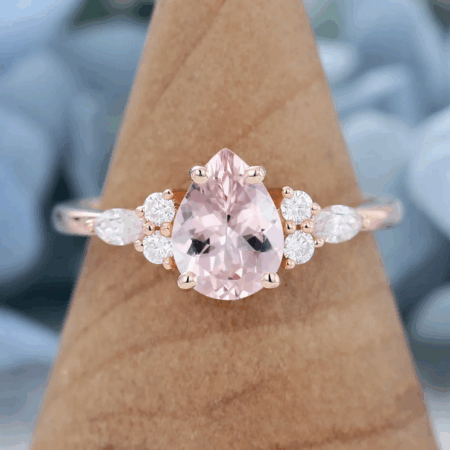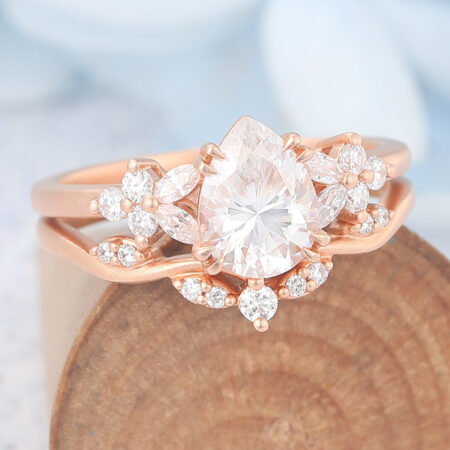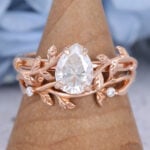Morganite vs Moissanite: A Complete Guide to Beauty, Value, and Durability
Morganite vs moissanite has become a popular comparison for anyone choosing between a romantic pastel pink gemstone and a sparkling, durable diamond alternative. Both gems offer unique beauty, lasting appeal, and value, but understanding their differences in color, brilliance, and wearability is key to making the right choice for your jewelry collection or special occasion.
What Is Morganite?
Morganite is a romantic pink gemstone with soft, delicate hues, belonging to the beryl family, alongside Emerald and Beryl. The pink Morganite ranges in color from pale pink to deep peach, often exhibiting a transparent, warm luster that enhances its visual appeal.

What Is Moissanite?
Moissanite is a rare and brilliant gemstone, renowned for its strong luster and remarkable brilliance. Moissanite gems’ color is typically near colorless, and with its affordable price, Moissanite has become a popular choice for modern engagement rings and fine jewelry.

Hidden Histories: The Stories Behind Morganite and Moissanite
Morganite
The story of the morganite stone begins in the early 20th century when it was first discovered in Madagascar. This delicate pink gem was later named in honor of the American financier J.P. Morgan, a passionate gem collector who greatly supported mineral research. Its soft blush color and connection to elegance and love soon made morganite a symbol of romance and emotional warmth, especially favored in vintage-inspired jewelry.
Moissanite
The moissanite origin traces back to something far more cosmic. It was first identified in 1893 by French chemist Henri moissan while studying fragments from a meteor crater in Arizona. This fascinating discovery gave rise to the history of moissanite — a gemstone literally born from the stars. Although natural moissanite is extremely rare, modern technology has made it possible to create lab-grown versions that capture the same.
Morganite vs Moissanite in Appearance and Sparkle
When comparing morganite and moissanite, their beauty reflects two distinct styles. Morganite stones captivate with soft blush-to-peach hues and a gentle inner glow. While their brilliance is lower than that of moissanite or diamonds, morganite still possesses a radiant, luminous charm that gives off a dreamy and romantic feel, perfect for those who value subtle sophistication.
In contrast, moissanite stones are celebrated for their exceptional fire and intense sparkle. With a refractive index of moissanite between 2.65 and 2.69, it surpasses diamond in brilliance, making it the gem that sparkles more than diamonds. Its vivid rainbow flashes and remarkable light performance make moissanite ideal for those drawn to eye-catching brilliance and modern glamour.
Morganite vs Moissanite in Durability and Hardness
When it comes to durability, both morganite and moissanite offer beauty with different levels of strength. The hardness of morganite falls between 7.5 and 8 on the mohs scale, giving morganite hardness moderate resistance to scratches but still requiring careful handling. Although durable enough for jewelry, its crystalline structure can be slightly brittle, making it better suited for protected or occasional wear.
In contrast, moissanite on mohs scale ranks around 9.25, placing it just below diamond in toughness and resilience. The exceptional hardness of moissanite and superior moissanite toughness make it highly resistant to daily wear, scratches, and chips. For those seeking a gemstone that combines lasting beauty with everyday practicality, moissanite stands out as the stronger and more enduring choice.
Morganite vs Moissanite in Color and Clarity
Color and clarity define the visual essence of both gemstones. Morganite is loved for its soft spectrum of colors, ranging from delicate blush pink to rich peach. Many stones undergo gentle heat treatment to enhance their tone, while natural inclusions may appear inside, giving each piece a distinctive, organic beauty that adds to its romantic appeal.
Lab grown moissanite, on the other hand, is admired for its near-colorless to faintly tinted look, closely resembling a high-quality diamond. On the moissanite clarity scale, most stones are graded as flawless or nearly flawless due to precise laboratory creation. This perfect clarity, combined with its intense sparkle, makes moissanite a symbol of brilliance, purity, and contemporary elegance.
Morganite vs Moissanite in Value and Affordability
When comparing the two, morganite is generally more affordable than moissanite, though both remain budget-friendly alternatives to diamonds. Morganite pricing depends largely on color intensity, clarity, and cut, with vivid peach-pink stones commanding higher prices. Despite this, the overall morganite cost tends to be lower, making it an appealing option for those seeking a romantic gemstone at an accessible price point.
The value of moissanite, however, comes from its unmatched brilliance, superior durability, and ethical origin. While slightly more expensive than morganite, moissanite still costs far less than a diamond and offers exceptional sparkle and longevity. For couples balancing elegance, sustainability, and long-term wear, moissanite stands out as the gemstone that delivers enduring beauty with excellent value.
Morganite vs Moissanite in Symbolism and Meaning
Both gemstones carry rich symbolism that reflects their appearance and emotional energy. Morganite meaning is deeply connected to love, compassion, and emotional healing. Known as the ‘heart stone,’ it is said to attract affection and strengthen relationships, embodying warmth and tenderness. The gentle morganite properties—its calming energy and soothing hues—make it a favorite among those who value emotional balance and harmony in their lives.
In contrast, the moissanite stone meaning centers on brilliance, strength, and eternal light. Symbolizing clarity and resilience, moissanite represents a love that endures through time. Its celestial origin and dazzling sparkle give it an otherworldly quality, making it a modern symbol of everlasting commitment and unwavering strength.
Morganite vs Moissanite in Sustainability and Ethical Factors
Sustainability is an important consideration when choosing gemstones, and both morganite and moissanite offer distinct advantages. Morganite stone benefits include its gentle, natural beauty and the fact that it is often mined responsibly as a byproduct, minimizing additional environmental impact. However, its ethical footprint depends on the transparency of the mining process.
On the other hand, moissanite is lab-grown, which makes it inherently sustainable and conflict-free. Many facts about moissanite highlight that, unlike mined gems, lab-grown moissanite requires no extensive mining, reducing environmental harm while still delivering dazzling sparkle and durability. For those prioritizing ethical sourcing and eco-friendliness, moissanite offers a clear advantage.
Morganite vs Moissanite Rings: Style and Setting Options
Morganite shines in designs that emphasize its soft pink hues and romantic appeal. Popular style options include vintage-inspired halos, delicate solitaires, and floral or intricate patterns that highlight its gentle glow. Setting options often focus on protective prongs or bezel settings to preserve its beauty while showcasing its elegant, understated charm.
Moissanite, by contrast, is ideal for styles that maximize sparkle and light performance. Its style options range from classic solitaires to bold multi-stone arrangements, while setting options often favor open prongs or raised settings to allow maximum light reflection, emphasizing its intense brilliance. Moissanite rings are perfect for those who want eye-catching sparkle in contemporary or statement designs.
Morganite vs Moissanite in Maintenance and Care Tips
Proper care ensures that both morganite and moissanite retain their beauty over time. Morganite is relatively durable but has a lower hardness, so it should be cleaned gently with mild soap and a soft brush. Avoid harsh chemicals, ultrasonic cleaners, or rough wear, and store it separately to prevent scratches. Regular inspections of prongs and settings help protect its delicate structure.
Moissanite, being harder and more resilient, is easier to maintain. It can withstand daily wear and regular cleaning with mild soap, water, and a soft cloth or brush. Its high hardness and toughness make it less prone to scratches or chips, but periodic checks of settings are still recommended to keep it secure and sparkling.
Morganite vs Moissanite, Which One Should You Choose?
Choosing between morganite and moissanite depends on what matters most to you in a gemstone. Morganite appeals to those who love soft, romantic hues and a gentle, timeless elegance at a more affordable price. Its pastel pink tones and warm glow make it ideal for sentimental pieces or vintage-inspired designs.
Moissanite, on the other hand, is perfect for those who prioritize brilliance, durability, and modern sparkle. With its diamond-like fire, high hardness, and ethical lab-grown origin, moissanite offers long-lasting beauty and everyday practicality. Ultimately, your choice comes down to whether you prefer the subtle warmth of morganite or the dazzling radiance of moissanite.
Morganite vs Diamond vs Moissanite
When comparing morganite, diamond, and moissanite, price and appearance are key factors. The morganite cost vs diamond is significantly lower, making morganite an affordable alternative for those seeking a romantic pink gemstone without the high price of diamonds. In terms of color, morganite vs pink diamond reveals a softer, more delicate blush, offering a gentle warmth that pink diamonds often display more vividly.
Moissanite, meanwhile, provides brilliance and durability closer to diamonds at a fraction of the cost. While it lacks the subtle pastel charm of morganite, its fiery sparkle and hardness make it ideal for those who want a diamond-like look with long-lasting strength and affordability.

Conclusion
When deciding between morganite vs moissanite, consider what matters most: morganite for romantic, soft hues and understated elegance, or moissanite for dazzling brilliance and long-lasting durability. Both gems stand the test of time in their own way.
FAQs About Morganite vs Moissanite
What is the difference between morganite and moissanite?
Morganite is a soft pink gemstone prized for its romantic hue, while moissanite offers intense brilliance and durability, making it ideal for daily wear.
Which one should I choose, moissanite or morganite?
Choosing between moissanite and morganite depends on your priorities. Moissanite offers exceptional brilliance, durability, and a diamond-like sparkle, making it ideal for everyday wear. Morganite, on the other hand, features a soft peach-pink hue and romantic charm but is less durable. If you prefer long-lasting sparkle, choose moissanite; if you love warm, feminine tones, morganite is the better choice.
Do moissanites scratch? What can scratch moissanite?
Moissanites are very hard, but they can be scratched by diamonds or materials higher on the mohs scale.
Does moissanite last?
Yes, moissanite is extremely durable and suitable for everyday jewelry due to its hardness and toughness.
Does moissanite change color over time (turn yellow)?
No, lab-created moissanite does not turn yellow and maintains its near-colorless appearance for years.
Is moissanite rare? How rare is moissanite?
Natural moissanite is extremely rare, but lab-grown moissanite is widely available, making it accessible for jewelry.
Is moissanite expensive?
moissanite is far more affordable than diamonds, offering brilliance and durability at a lower cost.
Is morganite lab created?
Yes, some morganite is lab created, providing consistent color and clarity while maintaining the gemstone’s romantic appeal.
Which gemstone is more durable, morganite or moissanite?
Moissanite is harder and more resistant to scratches and chips, while morganite requires more careful handling due to its lower hardness.
Do morganite and moissanite hold value over time?
Moissanite retains value due to its durability and sparkle, while morganite remains affordable but generally appreciates less than diamonds.



